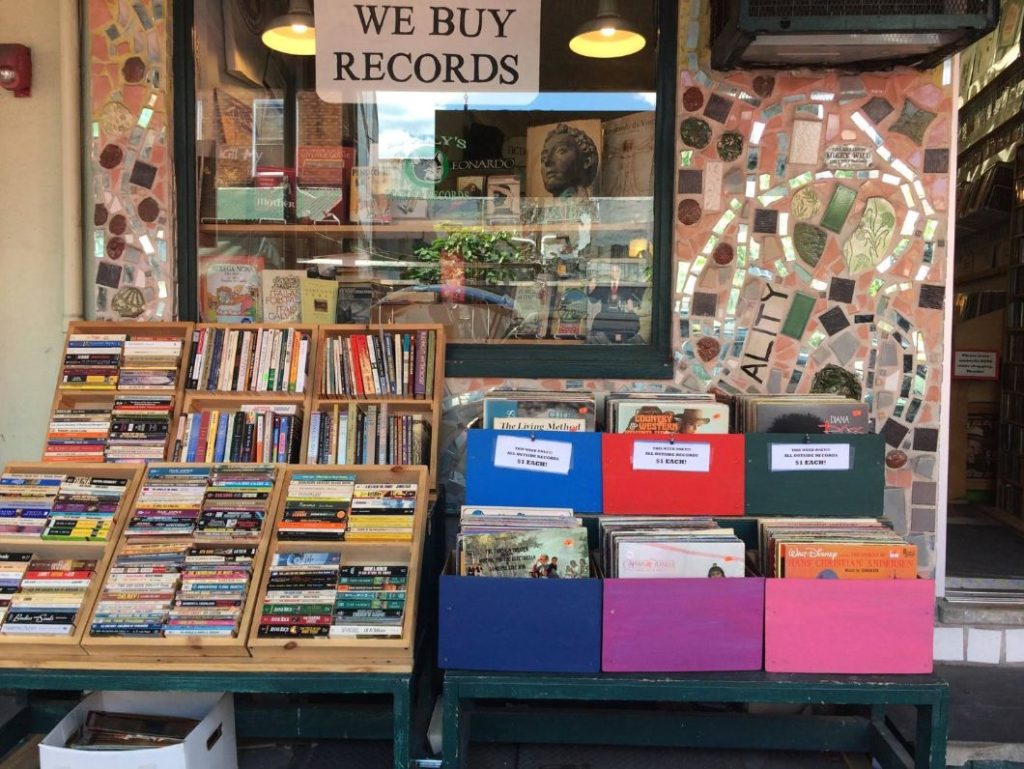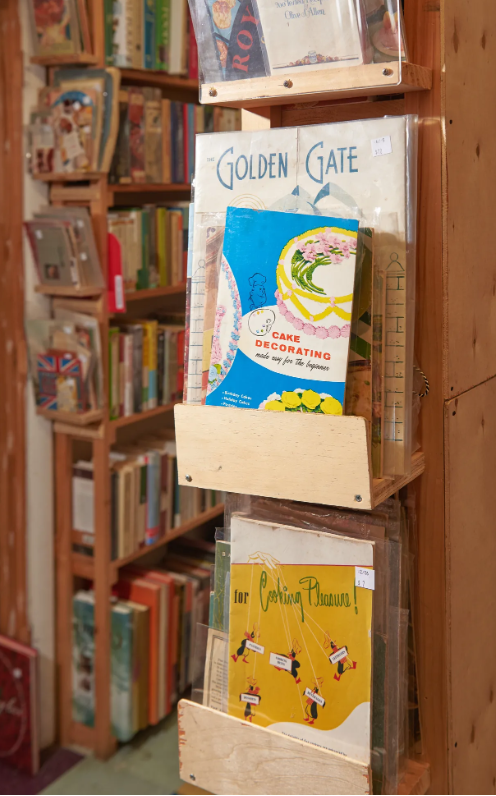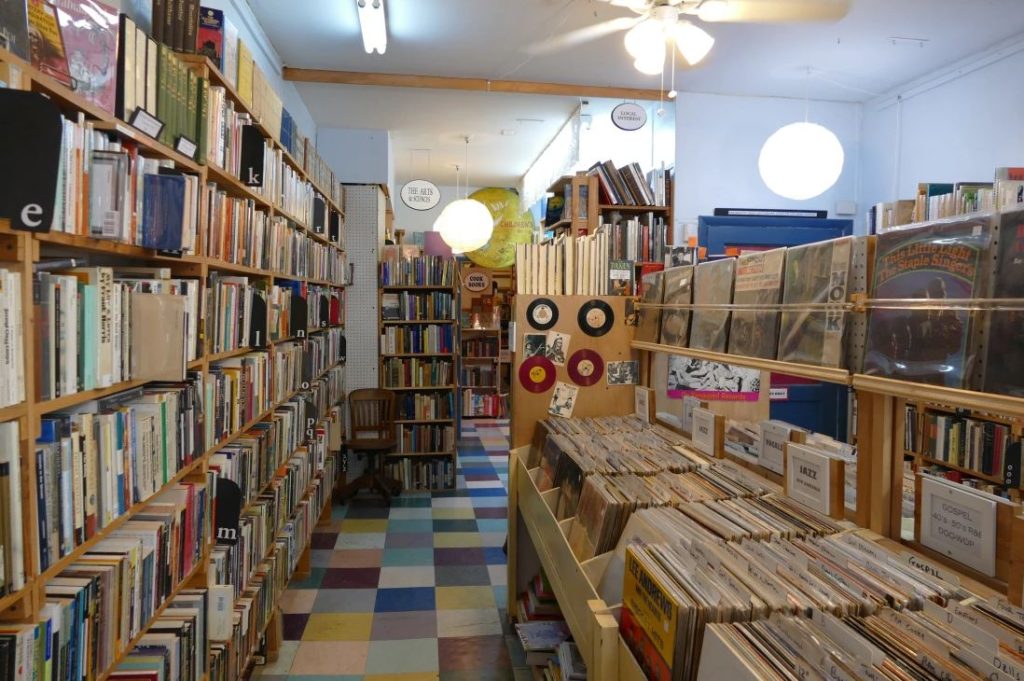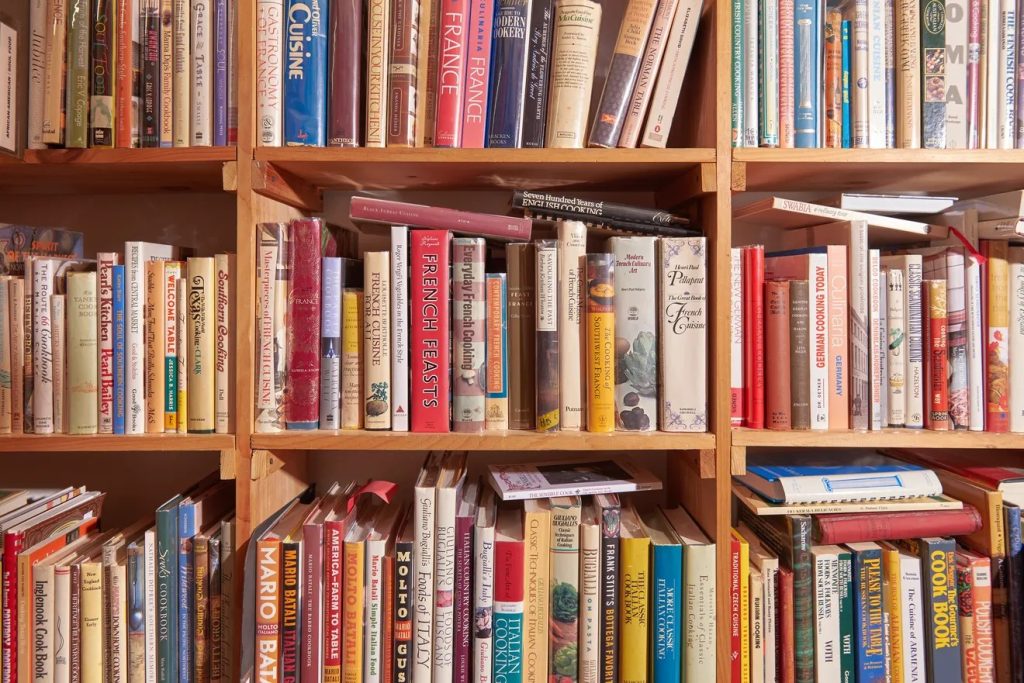Welcome Home: Molly’s Books & Records
By Ella Baker, Natalie Chamberlain, Kendall Reif, Lexie Kauffman, and Liann Quinones Melendez
In the heart of Philadelphia’s historic Italian Marketplace, Molly Russakoff invites wanderers into her home, Molly’s Books & Records. By sharing the unique culture of its surroundings, this personal bookstore blurs the line between business and family.

The eye-catching mosaic storefront coaxes guests off the streets and draws them to the boxes of bargain books, records, and movies that frame the front door. Russakoff’s touch is evident from the start; a hand-painted sandwich board sits alongside the curb and gems from her collection are featured in the window. It feels inviting and familiar, like returning home after a long day. Even before they take a step inside, Russakoff considers everyone guests rather than customers.
“It’s our home,” Russakoff said when asked about the atmosphere of her store. “We like to keep that feeling, where you’re coming into our home. [It’s] bright [and] organized. We like things to be easy to find and we like to be helpful and friendly.”
As the glass door opens, 600 square-feet of paradise is revealed where hand-painted signs hang proudly from the ceiling and colorful tile covers the floor. Russakoff knows that navigating a literary landscape can be daunting, and that’s why she meticulously crafted hand-painted signs for each section. They guide guests through the literary genres and authors, ensuring everyone can easily find their next great read. The signs point to different CD’s and records that line the wall to the right with the poetry section next to it. These shelves are symbolic of the owners themselves: Molly Russakoff and Joe Ankenbrand, a poet and musician.

Books and records are not the only items that reside within Russakoff’s place. Like many bookstores, Molly’s Books & Records sells non-book items around the store. According to Lydia Pyne, a historian and writer, “Putting not-books on a shelf in addition to actual books is a way of declaring one’s identity and individuality” (Pyne 25); Molly’s fully embodies Pyne’s ideas on expression through objects.
This is evident in the mugs and trinkets, adorned with beloved store motifs, that are thoughtfully placed, serving as a reminder that this is more than just a business; it’s a labor of love. Even more, scattered along the endcaps are notecards, featuring art from children’s books, a reminder that this is a space where the young and old come together to explore the loveliness of literature. The handmade nature of their not-books and the homey-feel of the mugs all point towards the larger theme of Molly’s Books & Records: home.

Inside this home, the check-out counter functions as a foyer. It’s directly to the left, usually staffed by Russakoff’s son, Johnny, or Russakoff and Ankenbrand themselves. The store cat, Mrs. Stevenson, roams the store and the apartment above, where Russakoff and her family live, effectively bridging the business and the family home. Even the family cat treats customers like they’re part of the family, choosing a lucky guest to tag-along with on their journey through the shelves.
The store is split into three general sections. The first section is the busiest and functions most like a family room, the hub of all household activity. Here, at the front of the store, Russakoff and Ankenbrand’s passions—poetry and music—are most on display. Past the checkout counter is a long wall of fiction. The shelves of books amass the space, from floor to ceiling. Pyne hypothesizes that bookshelves control how one interacts with a space. She states, “Bookshelves serve as powerful symbols” (Pyne 81). They “immediately cue us to how we ought to interact with a room and how much importance or power we assign it” (Pyne 81). Molly’s bookshelves welcome guests into the store and keep the space warm and homey. There is no social prejudice or hierarchy in the shelves that overflow with books. The lighter wood—oak, maybe pine—is inviting and approachable. This is an affordable wood that makes a bookshelf that doesn’t judge its customers or its contents. It’s not fancy; it’s simple, like it’s there for everyone to enjoy.

In addition to these bookshelves, Russakoff intentionally chooses the lighting for her store to curate a sense of comfort and ease. The fluorescent lights are chosen for their brightness, allowing customers to easily read titles on the shelves. However, Russakoff ensures that the lighting is not too harsh; it’s bright enough to facilitate browsing but soft enough to create a cozy and inviting atmosphere. In this subtle way, she makes the space accessible, not just physically but also aesthetically.
Russakoff’s commitment to creating an accessible space is reflected by the content she sells. All of the books are used—in other words, they’ve been loved before—and reasonably priced. They’re arranged with their spines out, and ordered alphabetically by the authors’ last names. Filled-to the brim and charmingly unpredictable, the shelves create a lived-in and happy atmosphere. The inventory is updated, relevant, and carefully organized. Russakoff’s curated selection of fiction is a testament to her own literary preferences, featuring titles by renowned authors like Atwood, Hemingway and Faulkner, among many others. Her wish is to share what she loves, whilst still having something for everyone who comes in.
The next section of Molly’s operates as a sitting room—a place of conversation, community and culture. It begins with two categories: Local and Philosophy/Religion. This section forms a rectangular alcove that has general nonfiction books to the right and art to the left. The other literature sections reflect different facets of personal life, each item handpicked. These things can all hold stories, memories, and meanings. On the top of the shelves, Russakoff displays her collection of rare and valuable books. She doesn’t cross paths with items like these frequently, but when she does, she ensures they are priced fairly while still receiving the return they deserve. The store is truly Russakoff’s personal library, as seen in the floor plan below.
A comprehensive floor plan of Molly’s Books & Records, originally drawn by Molly Russakoff. Please note that this is not drawn fully to scale.
Molly’s Books & Records leans into this personal aspect in every detail. This is evident when entering the heart of the home, the metaphorical kitchen. The cookbook room is signaled by a white and blue hand-painted sign that hangs above the narrow wooden doorway. Within the room, shelves overflow with cookbooks from an amalgamation of cuisines and cultures.

About seven years ago, Russakoff decided to bring her love of food and cooking into the bookstore via an extensive culinary collection. In this section, guests can find anything from general cookbooks to chef biographies. The selection is diverse and flexible because Molly’s Books & Records has a loose definition of food writing. Their stock includes “biographies and memoirs, essay collections by writers like MFK Fisher, and reference works” (Weil) as well as what one would expect. This space provides an important connection between Molly’s and the surrounding community, perpetuating the intentions of the Italian Market.
For over 40 years, Russakoff has lived and loved in The Italian Marketplace, a place of preserved culture and cuisine. The distinctive culture of the area reflects itself in a strong literary community, in which Russakoff is acutely connected.
Russakoff’s father, Jerome Russakoff, opened his own indie bookstore—Russakoff’s Books and Records—sometime between 1982 and 1986 on 259 South 10th Street. Eventually, in 1997 Jerome handed down ownership of the shop to Molly Russakoff’s brother, Joe Russakoff. Since then, Russakoff’s Books and Records has officially been known as Mostly Books and has relocated to 529 Bainbridge Street in the early 2000s. Considering this familial history of bookselling, it should not have come to any surprise that Molly Russakoff would continue the tradition and open up her own bookshop.
Around 2000, Russakoff purchased the property that Molly’s Books & Records currently operates on. Since then, she has opened and subsequently closed various businesses on this property: Molly’s Cafe, Bella Vista Natural Foods, and Molly’s Cafe and Bookstore. Russakoff raised her kids—Karla and Johnny—above the transformative space. This building is a part of the family, and she was determined to keep a business going in the community she loved.
This timeline tracks the history of Molly Russakoff, the owner of the independent bookstore Molly’s Books & Records in Philly, PA. It focuses on the idea of Molly’s shop as a homestead that has a long series of preceding events leading to its creation. By connecting each event to this idea of forming a ‘home’ within a bookstore, the development of Molly’s mindset toward her business is visible as well as the factors that have led to the success/resilience of Molly’s Books & Records.
In the late 2000’s, she partnered with her now-husband, Joe Ankenbrand. The two met after Rusakoff had just closed her store, and was planning to reopen once again as a bookstore. She was in possession of records that she didn’t know how to price. Ankenbrand, who knew Rusakoff’s brother, had been a vinyl record collector since 1964, so she went to him for advice. The two combined forces and the rest, as they say, was history.
Molly’s Books & Records opened in 2010, and a few years later, Russakoff and Ankenbrand were married in the bookstore, their home, surrounded by all the things they loved. They briefly ran an outlet for excess merchandise that did not fit the original store’s identity on Passyunk Avenue, a street away from the central location, but it was only open for a year and a half before the couple made the decision to close it. This experience made them realize that they’d rather focus their attention on one place and develop a single dedicated location for their guests: Molly’s Books & Records.
Every business venture Russakoff made in South Philadelphia was an attempt to create place, which according to human geographer Tim Cresswell is essentially defined as “a space invested with meaning” (Cresswell 12). Time and time again, Russakoff invested meaning into the building on 1010 South 9th Street. Every business she operated connected with the community and established relationships with the people of Bella Vista. Russakoff’s focus on home coincides perfectly with the history of the Italian Marketplace because South Philadelphia has been a haven for Italian immigration since the late 18th century. The map below works to further depict the way that Molly’s Books & Records functions within the surrounding Bella Vista neighborhood. It highlights the emphasis on food in the community and the businesses of various origins that call the neighborhood their home. Some markers work to show the emphasis on community in the area.
This map of Bella Vista features the locations of Molly Russakoff’s former businesses, showing us just how close together they have all been, and how Molly has repeatedly searched to establish her ‘home’ in the Italian Marketplace. Some markers on the map work to show the emphasis of community in the area.
Historically, Bella Vista was the core for Italian-immigrant life, and it was here that they attempted to preserve Italian identity in a Western culture. They moved into this neighborhood and worked hard to make it a multifunctional home. For example, when Italian immigrants settled in the neighborhood, they were able to adapt their housing to supply goods and services for Italian households. They would transform the first floor to be their shop, while using the rest of the building as a homestead, blurring the line between business and home even then. This historical architecture is still visible today in shops like Molly’s Books & Records. The bottom floor remains a commercial space to share cultures and passions, while the upper floor is Russakoff’s home where she raised her kids and lives a life of love.
9th Street’s Italian Market thrives on love, like Russakoff. Its retailers are beyond passionate, and its beauty comes from the rich individuality of every single place. In his work Defining Place, Cresswell goes on to assert that the idea of place is “…not so much a quality of things in the world but an aspect of the way we choose to think about it – what we decide to emphasize and what we decide to designate as unimportant” (Cresswell 11). Evidently, the neighborhood of Bella Vista has chosen to emphasize one thing in particular: food. Food is something that can be almost perfectly translated across place and time: with the same recipes and ingredients, food can be timeless. In fact, over one hundred years later, many of the original vendors and businesses remain in the area. However, the food market itself has diversified as new waves of immigration entered Philadelphia. In 1983, the first Korean-owned establishment joined the many businesses within the Italian Marketplace (Tangires). From then on, different cuisines—from Mexican, to Chinese, to Vietnamese—can now be found alongside the Italian classics. Currently, the Bella Vista neighborhood houses many different ethnicities, with 17.7% Italian descendants, 16.5% Irish descendants, and 11.7% of German descendants, according to the United States Census Bureau. The diversity in the community is manifested in rich history and a mutual love of food. The neighborhood’s vast population of restaurants and stores with food-related wares communicates a desire to preserve its residents’ culture.

The store symbolizes a genuine melting pot, as it serves the diverse community with culturally-enriched literature. Russakoff’s focus on cookbooks assists the neighborhood’s mission to define a sense of community and helps Molly’s Books & Records solidify their position in the culture of Bella Vista. In her book Reluctant Capitalists, sociologist Laura J. Miller explains that independent bookstores, such as Molly’s Books & Records, “assume position as cultural authorities” (Miller 84).
Molly’s Books & Records pursued this task of representing the culinary cultures of Bella Vista through a carefully curated cookbook collection. Considering Bella Vista’s history with immigration and cultural diversity, the cookbook collection extends its range far beyond the neighborhood’s Italian population with books “devoted to Pennsylvania Dutch, African American, Native American, Jewish, Scandinavian, Indian, and Middle Eastern cuisines, among others” (Weil). In their pursuit of diverse cultural representation through cookbooks, Molly’s Books & Records became the intersection of culinary and literary cultures in South Philadelphia.
This intersection creates a new and unique function of the store. It seems less like a commercial endeavor, and more like a place of learning. Russakoff invites guests into her home to share the history of the surrounding community as well as her own, almost like pulling old family photo albums out from the attic. She seems to make reading—and the exploration of lifestyles that comes with reading—approachable with her low prices, well-loved stock, and personally curated selection. Her store appears to be a convergence point of culture, providing knowledge for all.
Each book on her shelves is a lesson plan for the community. Russakoff’s definition of literature seems didactic—something that’s intended to teach life-lessons and broaden perspectives. The store may be a place of learning, but the books on the shelves provide the physical teaching materials. Some stock, like the cookbooks, are literal step-by-step instructions. The literature serves the guests and teaches the community, just waiting to be discovered and appreciated.
From the shelves, books and trinkets, to the host herself, this place welcomes everyone home. Molly’s Books & Records is a source of love—love for knowledge, love for oneself, love for community, love for culture, and love for food.
Works Cited
CBS Philadelphia. “Top Indie Bookshops in Philadelphia.” CBS News Philadelphia, 9 Feb. 2013, www.cbsnews.com/philadelphia/news/best-indie-bookshops-in-philadelphia/. Accessed 8 Oct. 2023.
Cresswell, Tim. “Defining Place.” Place: An Introduction, 2013, pp. 10-12.
DeMuro, Catherine. “Italian Market Q and A: Joe Ankenbrand, Co-Owner of Molly’s Books and Records on 9th Street.” The 9th Street Beat, 3 Mar. 2015, 9thstreetbeat.wordpress.com/2015/03/03/italian-market-q-a-joe-ankenbrand-co-owner-of-mollys-books-and-records-on-9th-street/. Accessed 8 Oct. 2023.
—. “Italian Market Q and A: Joe Ankenbrand, Co-Owner of Molly’s Books and Records on 9th Street.” The 9th Street Beat, 3 Mar. 2015, 9thstreetbeat.wordpress.com/2015/03/03/italian-market-q-a-joe-ankenbrand-co-owner-of-mollys-books-and-records-on-9th-street/. Accessed 8 Oct. 2023.
Edwards, Tamala. “Married Couple Shares Their Love of Books, Music at Molly’s Books and Records in South Philly.” ABC Action News, 3 Mar. 2022, 6abc.com/mollys-books-and-records-italian-market-south-philadelphia-art-of-aging/11617396/. Accessed 15 Sept. 2023.
Forsythe, Pamela J. “The Italian Legacy in Philadelphia: History, Culture, People, and Ideas.” Broad Street Review, 18 Jan. 2022, www.broadstreetreview.com/reviews/the-italian-legacy-in-philadelphia-history-culture-people-and-ideas-edited-by-andrea-canepari-and-judith-goode. Accessed 8 Oct. 2023.
“History.” S. 9TH ST. ITALIAN MARKET PHILADELPHIA, PA, www.italianmarketphilly.org/history.html. Accessed 9 Oct. 2023.
“Italian Market, Philadelphia.” Wikipedia, Wikimedia Foundation, 7 May 2023, en.wikipedia.org/wiki/Italian_Market,_Philadelphia. Accessed 8 Oct. 2023.
Kov, Daniel. “Molly’s Books and Records.” The Secondhand Beat, 12 Mar. 2011, thesecondhandbeat.wordpress.com/2011/03/12/mollys-books-records-part-ii/. Accessed 8 Oct. 2023.
—. “Mostly Books.” The Secondhand Beat, 9 Apr. 2011, thesecondhandbeat.wordpress.com/2011/04/09/mostly-books/. Accessed 8 Oct. 2023.
Luconi, Stefano. “Italians and Italy.” The Encyclopedia of Greater Philadelphia, 2017, philadelphiaencyclopedia.org/essays/italians-and-italy/#:~:text=It%20was%2C%20therefore%2C%20no%20surprise,and%20Leghorn%20in%20their%20homeland. Accessed 8 Oct. 2023.
Miller, Peter N. “How Objects Speak.” The Chronicle Review. Accessed 11 Aug. 2014.
Miller, Laura J. “Providing for the Sovereign Consumer: Selecting and Recommending Books.” Reluctant Capitalists: Bookselling and the Culture of Consumption, Chicago, 2007, pp. 55-85.
Prihar, Asha. “A Poet, a Doctor, a Muse: Meet the Bookstore Cats of Philadelphia.” Billy Penn at Whyy, 10 Oct. 2022, billypenn.com/2022/10/10/bookstore-cats-philadelphia-mollys-book-trader-pets/. Accessed 8 Oct. 2023.
Pyne, Lydia. “Bookshelves as Signs and Symbols.” Bookshelf, London, Bloomsbury Academic, an imprint of Bloomsbury Publishing, 2020.
—. “The Things That Go on a Bookshelf.” Bookshelf, London, Bloomsbury Academic, an imprint of Bloomsbury Publishing, 2020.
Russakoff, Molly. Personal interview with the author. 25 Oct. 2023.
The South 9th Street Italian Market Philadelphia. www.italianmarketphilly.org/. Accessed 8 Oct. 2023.
Tangires, Helen. “Italian Market.” The Encyclopedia of Greater Philadelphia, philadelphiaencyclopedia.org/essays/italian-market/. Accessed 8 Oct. 2023.
United States Census Bureau. data.census.gov/profile/ZCTA5_19147?g=860XX00US19147#employment. Accessed 19 Sept. 2023.
Weil, Abigail. “There’s No Place in Philly Quite like Molly’s Books & Records.” Eater Philadelphia, 13 Dec. 2021, philly.eater.com/2021/12/13/22820597/mollys-books-records-italian-market-bookstore-cookbooks. Accessed 8 Oct. 2023.
Images Used
C., Bri. _Yelp_, 31 July 2022, https://www.yelp.com/biz_photos/mollys-books-and-records-philadelphia?select=_hDaBMI9RDKwfe0JXcbr9A. 30 Nov. 2023.
C, Marietta. Arts and Sciences Section. 9 Dec. 2018, www.yelp.com/biz_photos/mollys-books-and-records-philadelphia?select=DpAPgT-ccTo6H4jLpuNVGw. Accessed 5 Dec. 2023.
—. Checkout Counter. 9 Dec. 2018, www.yelp.com/biz_photos/mollys-books-and-records-philadelphia?select=DpAPgT-ccTo6H4jLpuNVGw. Accessed 5 Dec. 2023.
—. Jazz Records. 9 Dec. 2018, www.yelp.com/biz_photos/mollys-books-and-records-philadelphia?select=DpAPgT-ccTo6H4jLpuNVGw. Accessed 5 Dec. 2023.
—. Rock and Pop Records. 9 Dec. 2018, www.yelp.com/biz_photos/mollys-books-and-records-philadelphia?select=DpAPgT-ccTo6H4jLpuNVGw. Accessed 5 Dec. 2023.
DeMuro, Catherine. Ankenbrand. The 9th Street Beat, 3 Mar. 2015, 9thstreetbeat.wordpress.com/2015/03/03/italian-market-q-a-joe-ankenbrand-co-owner-of-mollys-books-and-records-on-9th-street/. Accessed 8 Oct. 2023.
Ellen, Kirstie. Molly’s Books and Records. 2 Apr. 2018, ozbooksnail.com/2018/04/02/bookstores-to-visit-in-philadelphia-for-book-lovers/. Accessed 5 Dec. 2023.
Kauffman, Lexie. “Molly’s Books and Records.” 30 Oct. 2023, www.thinglink.com/scene/1775744508353315302. Map.
Molly’s Books and Records. 3 Nov. 2018, www.tangfamily.me/italian-market/. Accessed 5 Dec. 2023.
Molly’s Books and Records, _FaceBook_, 1 June 2017, https://www.facebook.com/mollysbooksandrecords/photos/pb.100066605814222.-2207520000/1489619537762206/?type=3. 30 Nov. 2023.
Molly’s Books & Records Family: “Married Couple Shares Their Love of Books, Music at Molly’s Books and Records in South Philly.” 6abc Philadelphia, 3 Mar. 2022, 6abc.com/mollys-books-and-records-italian-market-south-philadelphia-art-of-aging/11617396/.
Piserchio, Natalie. Shelves. Eater Philadelphia, 13 Dec. 2021, https://philly.eater.com/2021/12/13/22820597/mollys-books-records-italian-market-bookstore-cookbooks. Accessed 30 Nov. 2023.
Piserchio, Natalie. Molly Russakoff. Eater Philadelphia, 13 Dec. 2021, philly.eater.com/2021/12/13/22820597/mollys-books-records-italian-market-bookstore-cookbooks. Accessed 8 Oct. 2023.
Piserchio, Natalie. End Cap. Eater Philadelphia, 13 Dec. 2021, philly.eater.com/2021/12/13/22820597/mollys-books-records-italian-market-bookstore-cookbooks. Accessed 8 Oct. 2023.
Records for Sale. Map Quest, www.mapquest.com/us/pennsylvania/mollys-books-and-records-2345352. Accessed 15 Sept. 2023.
Storefront. Eater Philly, 13 Dec. 2021, philly.eater.com/2021/12/13/22820597/mollys-books-records-italian-market-bookstore-cookbooks. Accessed 15 Sept. 2023.
TK. Molly’s Fiction Wall. Foursquare City Guide, 5 Sept. 2016, foursquare.com/v/mollys-books–records/4b98037df964a520142635e3?openPhotoId=57cdc4a4498e532c6a207b36. Accessed 1 Nov. 2023.
Weil, Abigail. Cookbooks. Eater Philadelphia, 13 Dec. 2021, philly.eater.com/2021/12/13/22820597/mollys-books-records-italian-market-bookstore-cookbooks. Accessed 8 Oct. 2023.

0 Comments